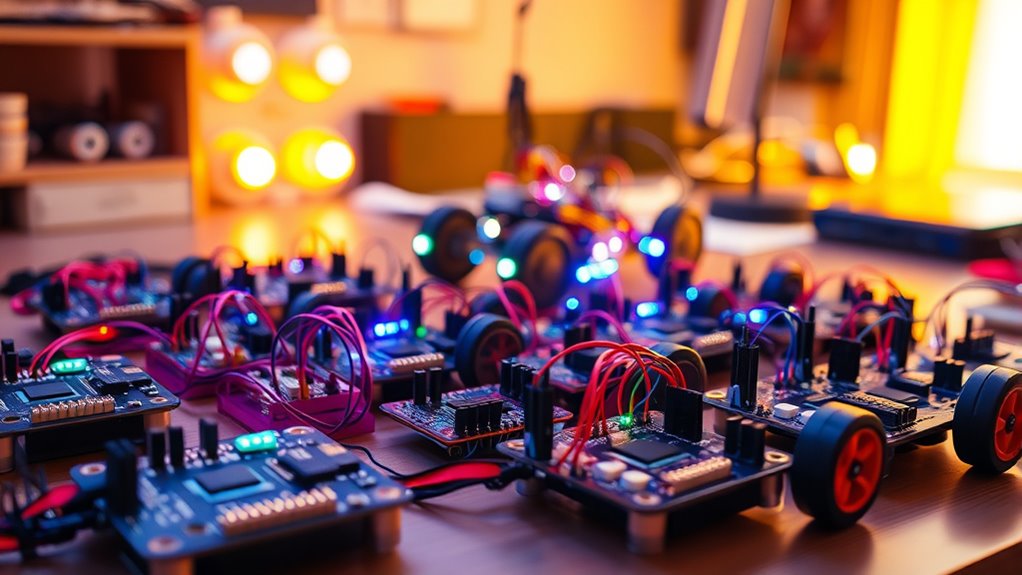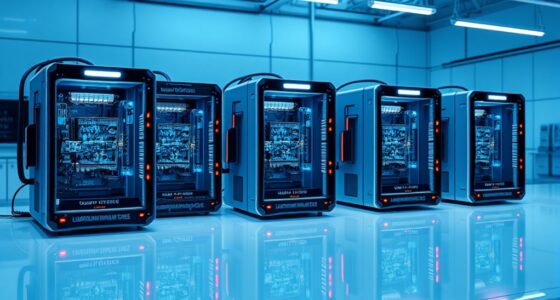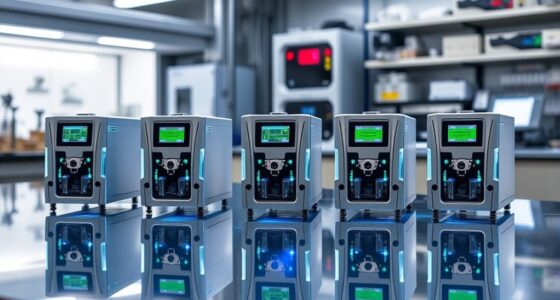If you’re looking for the best microcontroller kits to jumpstart your robotics projects, I recommend exploring options like the ELEGOO UNO R3, Mega R3, and robot car kits, as well as Makeblock’s mBot and mBot2. These kits offer reliable hardware, a wide range of components, and user-friendly features suitable for beginners, students, and hobbyists. Keep in mind factors like compatibility and tutorials. If you continue, you’ll discover detailed insights to help you choose the perfect kit for your needs.
Key Takeaways
- Comprehensive kits like ELEGOO and Makeblock offer essential sensors, motors, and controllers for building diverse robotics projects.
- Beginner-friendly options include tutorials, step-by-step guides, and compatibility with Arduino IDE to ease learning.
- Advanced kits support features like obstacle avoidance, FPV camera control, and multi-control modes for complex robotics.
- High-quality components and durable build design ensure reliability and longevity for experimental and long-term projects.
- Compatibility with popular microcontrollers like Arduino, Raspberry Pi, and ESP32 expands customization and project possibilities.
ELEGOO UNO Project Starter Kit with UNO R3 Board
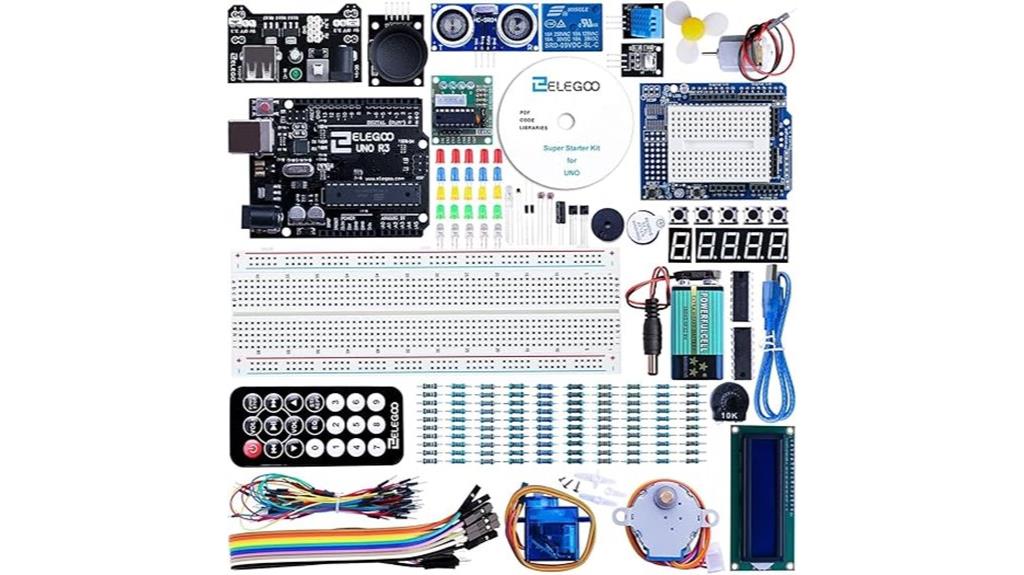
If you’re just starting out in robotics or electronics, the ELEGOO UNO Project Starter Kit with UNO R3 Board is an excellent choice because it offers a complete set of components that are easy to use and compatible with popular platforms like Arduino and Raspberry Pi. The kit includes a sturdy UNO R3 microcontroller, sensors, modules, LEDs, a display, wires, and accessories, making it versatile for a variety of projects. With over 22 beginner-friendly tutorials, it guides you through basic coding and circuit connections. Its organized packaging and reliable hardware help build confidence, making it ideal for both learning and experimenting with microcontrollers.
Best For: beginners, hobbyists, and students interested in learning electronics, coding, and microcontroller projects with a comprehensive, easy-to-use kit.
Pros:
- Includes a wide variety of components and accessories suitable for multiple projects
- Comes with over 22 beginner-friendly tutorials and clear instructions
- Organized packaging and reliable hardware promote an easy setup and confident experimentation
Cons:
- Software and setup instructions for Mac OS are less detailed, requiring some user troubleshooting
- Some users may find the online tutorials and guides too basic or overview-based
- Limited advanced project support within the included resources, requiring supplementary online research
ELEGOO Mega R3 Arduino Starter Kit
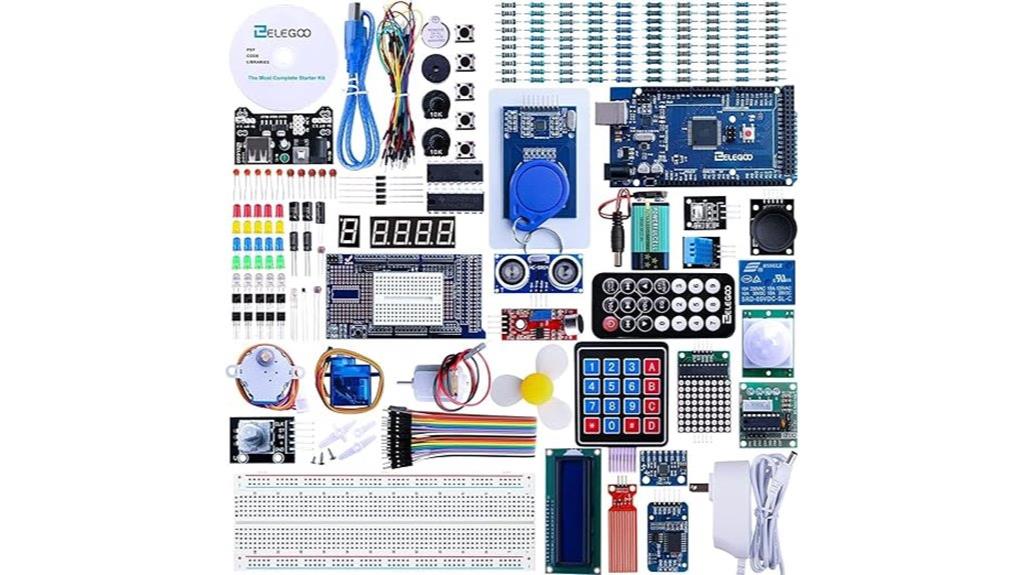
The ELEGOO Mega R3 Arduino Starter Kit stands out as an excellent choice for beginners and hobbyists enthusiastic to explore robotics and electronics. It includes a Mega2560 board and over 200 components like sensors, motors, LEDs, and buttons, all stored neatly in compartmentalized cases. The kit offers thorough tutorials with easy-to-follow instructions, sample code, and diagrams, making learning straightforward. While some components like jumper wires and resistors are lightweight, the quality of the main components is solid. With tools for experimentation and expansion, this kit provides a versatile platform for building projects like automation, motor control, and sensor integration.
Best For: beginners, hobbyists, and students eager to learn Arduino programming, electronics, and project development with a comprehensive starter kit.
Pros:
- Includes a wide variety of over 200 components for versatile experimentation and project building
- Comes with detailed tutorials, step-by-step guides, and sample code suitable for beginners
- No soldering required; components like LCD and sensors come with pin headers for easy assembly
Cons:
- Some components like jumper wires and resistors are lightweight and may be of lower quality
- Certain modules and sensors may need upgrading for durability or higher performance
- The included 9V battery is inadequate for long-term or high-power applications
ELEGOO UNO R3 Robot Car Kit for Arduino STEM Science Kits for Kids
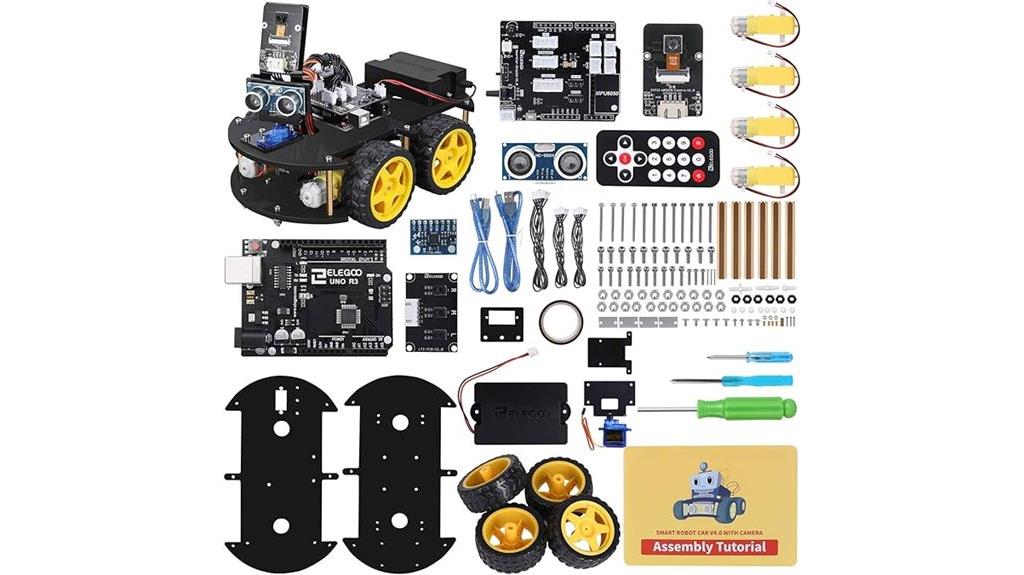
Designed for beginners and young learners, the ELEGOO UNO R3 Robot Car Kit stands out as an ideal STEM educational tool that combines ease of assembly with versatile control options. It includes 24 modules like obstacle avoidance, line tracing, infrared remote, and Bluetooth control via phones and tablets. The kit features ultrasonic sensors for collision prevention, optical sensors for line following, and supports semi-autonomous navigation. With clear instructions and beginner-friendly interfaces, it’s perfect for kids age 8+ with basic electronics knowledge. This kit encourages hands-on learning in programming, electronics, and robotics, making it a fun and practical way to jumpstart your projects.
Best For: beginners, kids, and hobbyists interested in learning robotics, programming, and electronics through a versatile and educational STEM kit.
Pros:
- Easy to assemble with clear instructions and beginner-friendly interfaces
- Includes a wide range of modules such as obstacle avoidance, line tracing, and Bluetooth control for versatile experimentation
- Supports modification and upgrades, fostering creativity and technical skills
Cons:
- Assembly can be challenging for complete beginners, especially with symmetrical parts and sensor mounting
- Limited WiFi range and IR remote control distance, which may affect usability in some environments
- Software setup and library management can cause compatibility issues, requiring troubleshooting and updates
Makeblock mBot Robot Kit for Kids Ages 8-12 STEM Toy with Scratch & Arduino
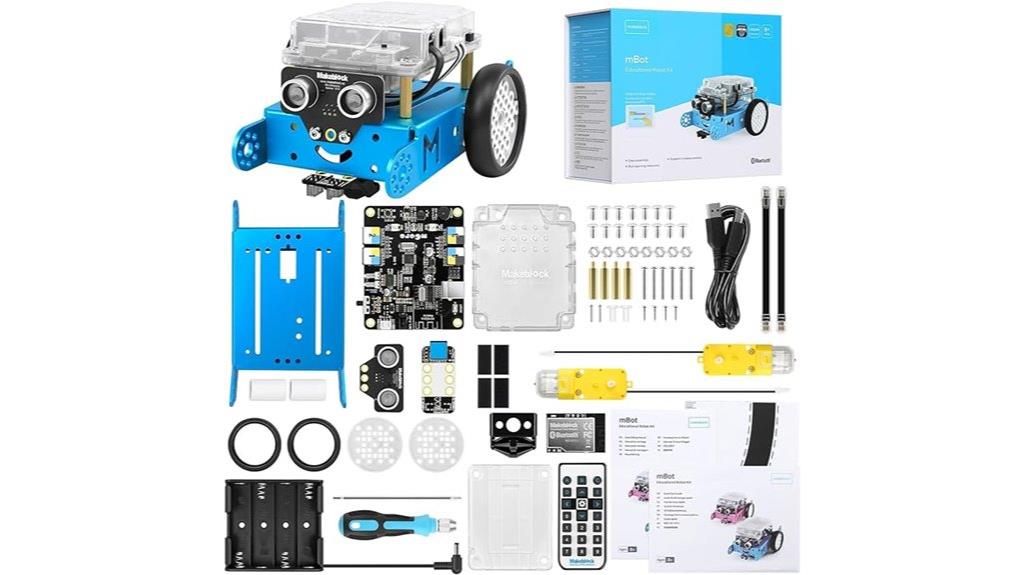
Children aged 8 to 12 who are enthusiastic to explore robotics and coding will find the Makeblock mBot Robot Kit an ideal starting point. It’s designed to introduce kids to electronics, robotics, and programming with step-by-step guidance. The kit supports both Scratch and Arduino, encouraging progression from beginner to more advanced coding. Assembly is straightforward, taking about 15-20 minutes, and the sturdy metal parts withstand rough handling. With features like obstacle avoidance and line-following, plus compatibility with over 100 modules and LEGO components, this kit offers endless customization. It’s perfect for sparking creativity, learning, and having fun with STEM projects.
Best For: children aged 8-12 interested in learning robotics, electronics, and programming through a fun and educational STEM kit.
Pros:
- Easy to assemble with clear instructions, taking approximately 15-20 minutes.
- Supports both Scratch and Arduino programming for a gradual learning curve.
- Highly customizable with over 100 electronic modules, 500 parts, and compatibility with LEGO components.
Cons:
- Software and firmware may require debugging and updates for optimal performance.
- Limited levels in the app may restrict advanced users seeking more complex challenges.
- Slightly fragile battery pack integration could benefit from improved design.
Makeblock mBot2 Coding Robot for Kids

If you’re looking for an accessible robotics kit that combines ease of use with extensive educational features, the Makeblock mBot2 Coding Robot is an excellent choice for kids aged 8 to 12. Its durable build from high-quality materials, including anodized aluminum, allows quick assembly in just 30 minutes. With over 10 sensors supporting line-following, obstacle avoidance, and color detection, plus expandable modules for IoT projects, it offers versatile learning opportunities. Control options include app, Bluetooth, Wi-Fi, and USB, supporting block coding, Scratch, and Python. Its interactive features, like voice control and project-based learning, make it engaging and perfect for both classroom and home STEM activities.
Best For: kids aged 8-12 interested in learning robotics, coding, and STEM concepts through an easy-to-assemble, durable, and feature-rich robot kit.
Pros:
- Easy assembly within 30 minutes, suitable for beginners and kids
- Supports multiple control options including app, Bluetooth, Wi-Fi, and USB
- Extensive sensor array and expandable modules for diverse learning projects
Cons:
- Initial setup may be challenging for some children due to software interface messages in Chinese
- Requires 1 AAA battery, which may need frequent replacement
- Advanced programming features like Python may require additional learning resources for beginners
ELEGOO Conqueror Robot Tank Kit with UNO R3 for Arduino Robotics
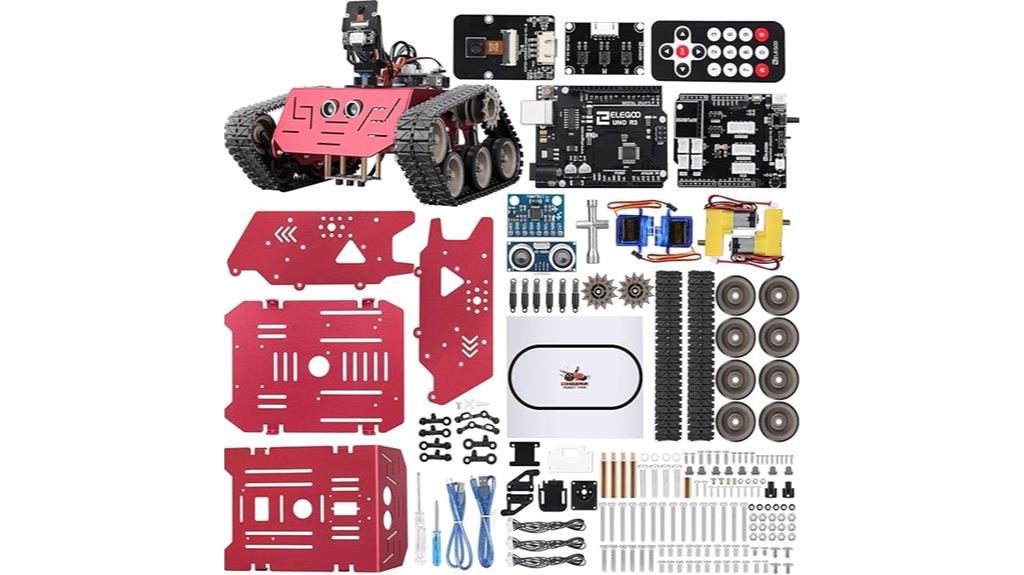
The ELEGOO Conqueror Robot Tank Kit with UNO R3 is an excellent choice for beginners and young robotics enthusiasts enthusiastic to explore Arduino-based projects. Its open resources and rich learning materials make it perfect for DIY assembly, developing focus, manual skills, and engineering understanding. The kit includes graphical programming with building block functions, fostering creativity. With features like FPV camera control, remote operation, and app compatibility, it offers immersive, hands-on experiences. Built with sturdy components, it handles rough terrain and includes a durable metal chassis. While some assembly challenges exist, the overall educational value, fun, and upgrade potential make it a top pick for aspiring robot builders.
Best For: beginners, young robotics enthusiasts, and DIY hobbyists interested in Arduino-based projects and educational robotics.
Pros:
- Open resources and rich learning materials foster creativity and hands-on skills.
- Durable metal chassis and quality components suitable for rough terrain and off-road use.
- Includes FPV camera and app control for immersive and versatile operation.
Cons:
- Assembly can be challenging for complete beginners and may require patience.
- Some components, like tracks and screws, may need reinforcement or upgrades for long-term durability.
- Remote control functionality can be buggy or less responsive, with some users preferring app control.
Arduino UNO R3 Super Starter Kit with Tutorial and Controller Board
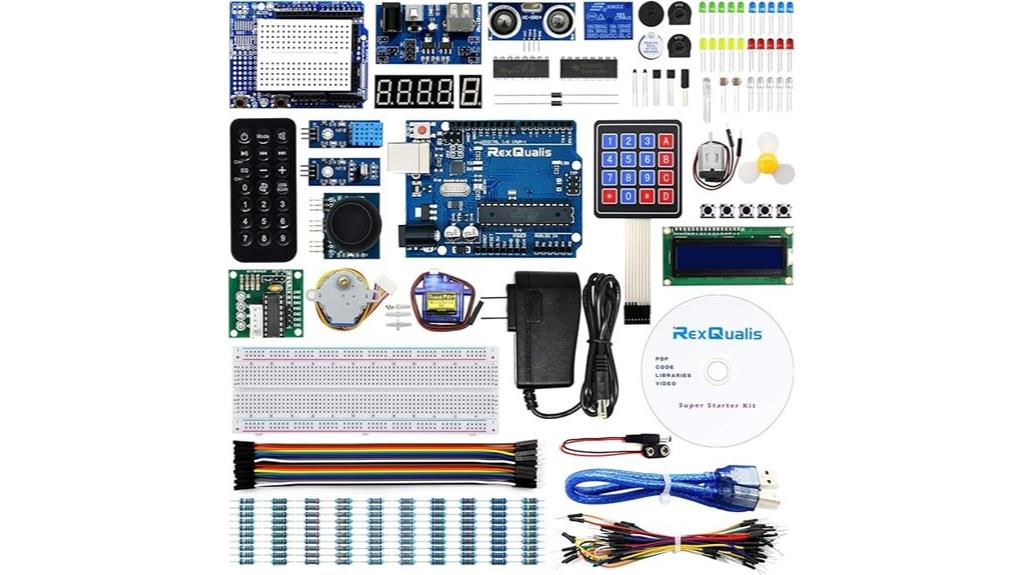
The Arduino UNO R3 Super Starter Kit with Tutorial and Controller Board is an ideal choice for beginners keen to explore robotics and electronics. It offers over 200 components, including an Arduino UNO R3 compatible board, LCD, sensors, motors, servos, LEDs, buzzers, and more, all neatly organized in a sturdy box. The kit includes a 9V power adapter and detailed datasheets, making setup straightforward. Compatible with Arduino IDE, it supports hands-on experimentation with projects like motor control and temperature sensing. While tutorials provide practical guidance, they lack depth in programming concepts, so supplementing with external resources is recommended for a thorough learning experience.
Best For: beginners and educators seeking a comprehensive, organized electronics starter kit to learn robotics, programming, and hardware integration.
Pros:
- Extensive components (over 200 pieces) for diverse projects and experimentation
- Well-organized packaging with datasheets and tutorials to facilitate learning
- Compatible with Arduino IDE, supporting easy programming and hardware setup
Cons:
- Tutorials lack in-depth programming guidance, requiring external resources
- Short USB A-to-B cable may be inconvenient for desktop use
- Limited explanation of hardware behavior in the provided tutorials
ELEGOO UNO R3 Starter Kit V2.0 with Tutorials for Arduino STEM Projects
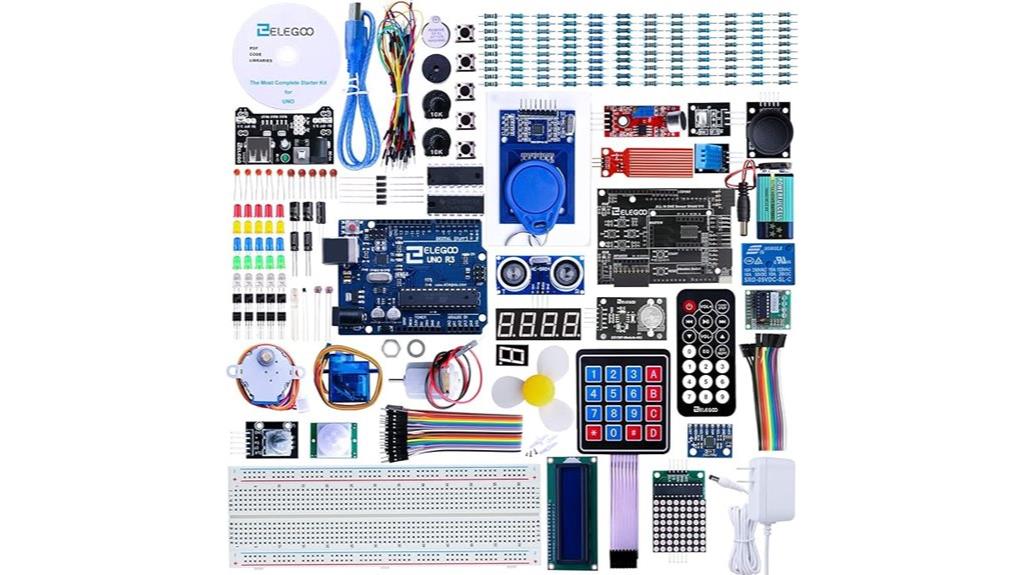
Designed for both beginners and experienced electronics enthusiasts, the ELEGOO UNO R3 Starter Kit V2.0 offers an extensive and organized platform to explore Arduino-based STEM projects. It’s fully compatible with all Arduino modules, making it versatile for robotics, coding, and engineering tasks. The kit includes high-quality parts, an inline expansion shield, and protective packaging to prevent damage. With new tutorials covering C programming, library management, and projects like Retro Snake and Alarm Clock, it promotes hands-on learning. Online resources, such as YouTube tutorials, further support users. Overall, this kit provides a thorough, user-friendly introduction to electronics, ideal for hobbyists and students aged 14 and up.
Best For: beginners and experienced electronics enthusiasts seeking a comprehensive, compatible Arduino STEM project kit with extensive tutorials and quality components.
Pros:
- Fully compatible with all Arduino modules, ensuring versatility for various projects
- Includes high-quality parts and protective packaging to prevent damage
- Comes with detailed tutorials and online resources to support learning
Cons:
- Some users find the included instructions limited and may need additional guidance
- Additional accessories like breadboards might require separate purchase due to tight internal space
- The kit’s complexity may be overwhelming for absolute beginners without prior electronics experience
ELEGOO Tumbller Self-Balancing Robot Kit for Arduino Robotics for Kids
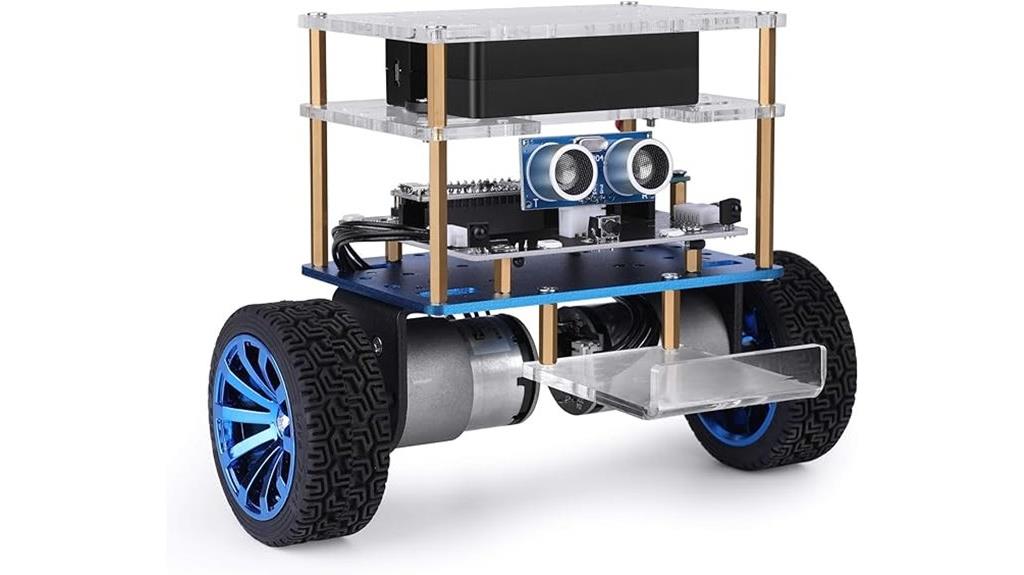
If you’re looking for a beginner-friendly robotics kit that combines ease of assembly with advanced features, the ELEGOO Tumbller Self-Balancing Robot Kit is an excellent choice for kids and hobbyists aged 8 and up. It offers multiple functions like obstacle avoidance, auto-follow, bouncing mode, and mobile phone control via the ELEGOOKit app. The kit is easy to assemble with clear tutorials and uses durable parts, requiring only basic tools. Compatible with Arduino Nano and supporting customization through sensors and code modifications, it provides an engaging way to learn robotics, programming, and control systems while being suitable for both beginners and more advanced users.
Best For: beginners and hobbyists aged 8 and up seeking an easy-to-assemble, feature-rich robotics kit for learning programming and control systems.
Pros:
- User-friendly assembly with detailed tutorials and durable parts suitable for beginners
- Supports customization and expansion with sensors and code modifications via Arduino IDE
- Features multiple modes like obstacle avoidance, auto-follow, and mobile app control for engaging learning experiences
Cons:
- Slight instability due to wheel-motor connection wobbling may affect performance
- Software and source code can be somewhat difficult to locate or access initially
- Limited market popularity, with a ranking of #29,663 in Toys & Games, indicating moderate availability
OSOYOO Smart Robot Car Kit for Arduino

For beginners and young learners interested in robotics, the OSOYOO Smart Robot Car Kit for Arduino offers an accessible and all-inclusive way to build and program functional robots. It includes Arduino-compatible boards, sensors, motors, Bluetooth modules, and accessories that enable features like obstacle avoidance, line tracking, auto-driving, and remote control. The kit’s design simplifies assembly with a clear chassis and integrated motor shield, making wiring straightforward. Supported by detailed tutorials and responsive customer service, it’s ideal for developing mechanical, electrical, and programming skills. While some hardware issues may arise, upgrading batteries and consulting additional resources can enhance the experience, making it a valuable educational tool.
Best For: beginners and young learners interested in hands-on robotics education, looking to develop mechanical, electrical, and programming skills with an all-inclusive, user-friendly kit.
Pros:
- Comprehensive set with Arduino-compatible boards, sensors, motors, and accessories for versatile robot functionalities
- Clear chassis design and integrated motor shield simplify assembly and wiring
- Supported by detailed tutorials, schematics, and responsive customer service for troubleshooting
Cons:
- Some hardware parts, such as screws and components, may be missing or inconsistent, complicating assembly
- Documentation and tutorials can be outdated or unclear, requiring additional external resources
- Limited remote control range and motor calibration issues may require modifications or upgrades
GAR Monster Arduino Starter Kit with Sensor Modules and WiFi/Ethernet for STEM Projects
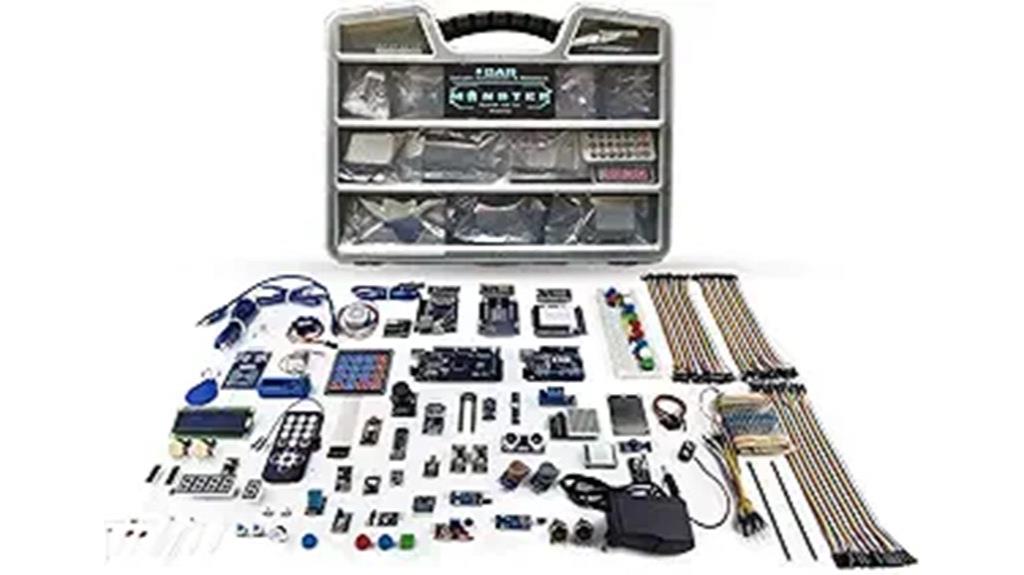
The GAR Monster Arduino Starter Kit stands out as an ideal choice for both beginners and experienced hobbyists who want a complete, all-in-one robotics and electronics set. It includes over 65 components across five development boards, like Arduino Uno, Mega, Nano, ESP32, and ESP8266, along with a variety of sensors, modules, motors, and displays. The well-organized toolbox, detailed tutorials, and support make it easy to start projects in STEM, IoT, and automation. High-quality components from reputable manufacturers ensure reliability, while the extensive educational resources help users learn quickly. Despite minor issues, this kit offers excellent value and versatility for anyone looking to jumpstart their robotics journey.
Best For: hobbyists, students, and educators seeking a comprehensive Arduino-based robotics and electronics kit for STEM, IoT, and automation projects.
Pros:
- Extensive selection of over 65 components across multiple development boards including Arduino Uno, Mega, Nano, ESP32, and ESP8266.
- High-quality, reliable parts from reputable manufacturers, suitable for complex projects and educational purposes.
- Rich educational resources, tutorials, and support, making it ideal for beginners and advanced users alike.
Cons:
- Some datasheets and documentation for specific components like servos or thermistors may be outdated or missing.
- Minor issues such as missing jumper wires or bent soldered parts reported by users.
- Slightly higher price point compared to basic starter kits, which may be a consideration for budget-conscious buyers.
Robotic Arm with Arduino 5DOF/Axis Educational Robotics Kit
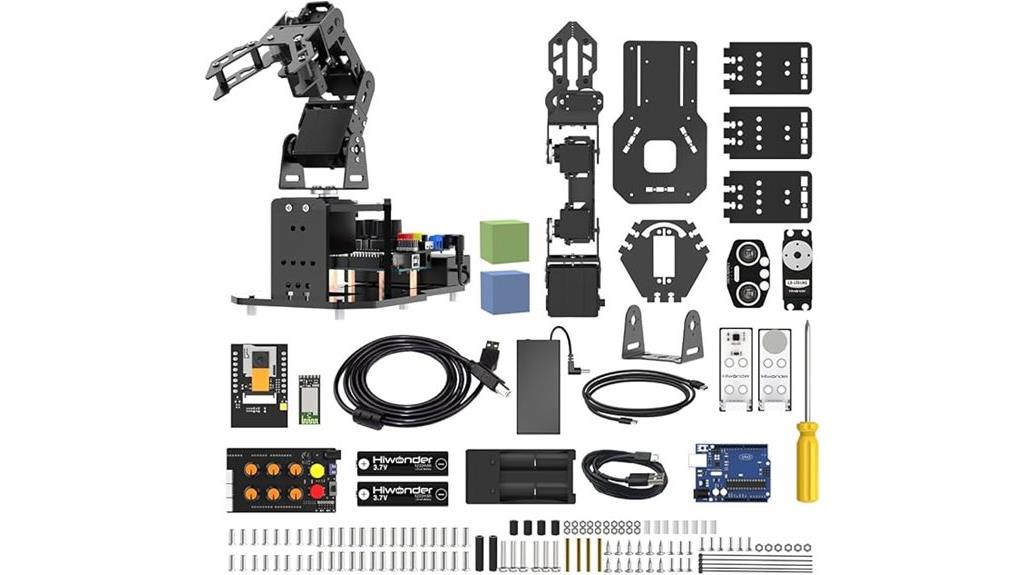
Designed for educators, hobbyists, and students with some programming experience, the Robotic Arm with Arduino 5DOF/Axis Educational Robotics Kit offers a practical way to explore robotics, automation, and engineering fundamentals. Its high-quality hardware includes digital servos, Bluetooth, and expansion ports for sensors, supporting diverse projects. Built on the Arduino platform, it’s compatible with open-source software and tutorials, allowing customization and expansion. While assembly is straightforward and the build durable, some users find the software documentation limited, making programming challenging for beginners. Overall, it’s a versatile, expandable kit ideal for intermediate learners seeking hands-on experience and project development.
Best For: intermediate educators, hobbyists, and students with some programming experience seeking a durable, expandable robotic arm for educational and project development purposes.
Pros:
- High-quality hardware with durable, precise digital servos and robust build
- Open-source compatibility with Arduino platform, offering customization and expansion options
- Versatile, supporting various sensors and accessories for diverse robotics projects
Cons:
- Limited and superficial software documentation, making programming difficult for beginners
- Not included with Arduino Uno R3, requiring additional purchase for complete setup
- May be challenging for complete beginners due to the complexity of assembly and coding
OSOYOO 2WD Robot Car Starter Kit for Arduino
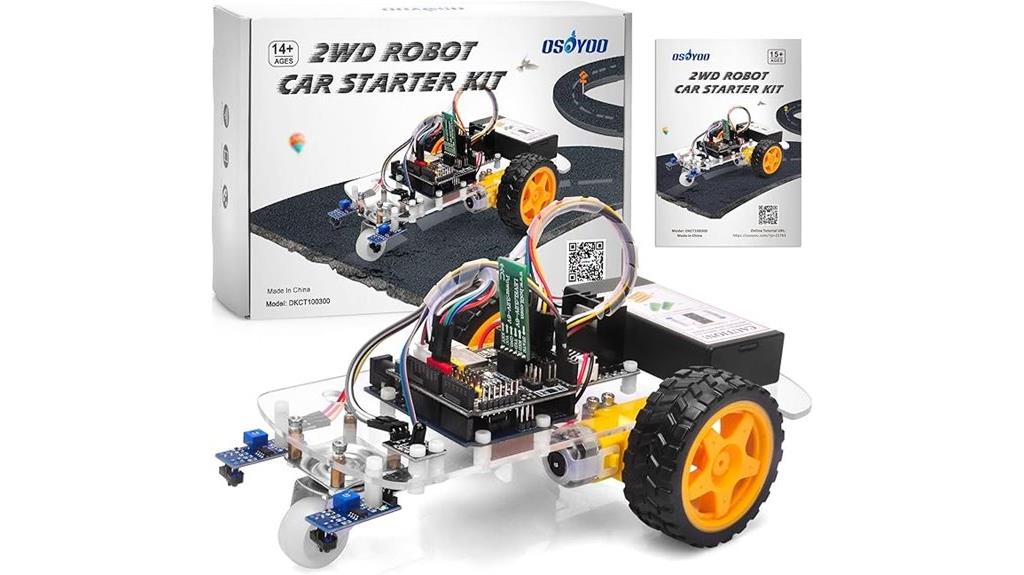
If you’re a STEM beginner enthusiastic to plunge into robotics, the OSOYOO 2WD Robot Car Starter Kit for Arduino offers a versatile starting point. It features hands-on Arduino programming and electronics assembly, supporting multiple control modes like Wi-Fi, infrared, line tracking, and Bluetooth. The kit includes a car chassis, sensors, and modules, with improved wiring sockets for easier setup. While the tutorials guide you step-by-step, some users find assembly and troubleshooting challenging due to documentation gaps and hardware inconsistencies. Priced reasonably, it’s ideal for those with some experience, but beginners might face difficulties without additional guidance or sensor components.
Best For: STEM enthusiasts with some experience in Arduino programming who are seeking a versatile, connectivity-rich robotic car starter kit to expand their robotics projects.
Pros:
- Supports multiple control modes including Wi-Fi, infrared, Bluetooth, and line tracking for versatile experimentation.
- Features improved wiring sockets that simplify assembly and enhance wiring stability.
- Comes with step-by-step web tutorials that facilitate progressive learning and project development.
Cons:
- Assembly can be challenging due to documentation gaps, wiring shortages, and hardware inconsistencies.
- Lacks some standard sensors like ultrasonic transceivers, limit switches, and servos, limiting certain applications.
- Quality control issues such as unresponsive components and confusing documentation for different shield versions may impact user experience.
Robot Car Kit, 2 in 1 Smart Robotics Arm Building Toy for Raspberry Pi Python Coding
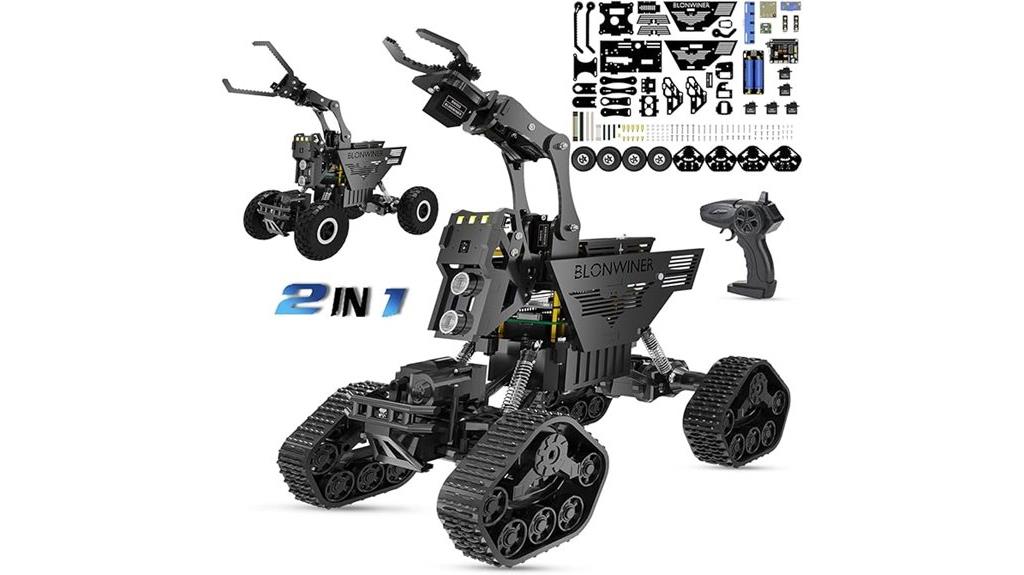
For anyone enthusiastic to plunge into hands-on robotics and coding, the Robot Car Kit offers an engaging 2-in-1 experience that supports Raspberry Pi platforms. You can build a robot car or a robotic arm, perfect for ages 14 and up. The kit includes components like tank tires, RGB lights, and a camera for real-time visuals, enhancing learning and fun. It supports web and remote control via phones, tablets, and computers without app downloads, with control through screen buttons and customizable code. While assembly can be challenging due to hardware and instruction issues, it provides valuable experience in electrical systems, Python coding, and robotics.
Best For: hobbyists and students aged 14 and up interested in hands-on robotics, STEM education, and coding with Raspberry Pi platforms.
Pros:
- Offers a versatile 2-in-1 design allowing building of both a robot car and robotic arm for varied learning experiences.
- Supports web and remote control without app downloads, facilitating easy access via multiple devices.
- Enhances STEM skills through practical Python coding, electrical systems, and robotics assembly.
Cons:
- Assembly can be complex, with unclear instructions and hardware quality issues such as broken parts and oversized holes.
- Hardware components like the chassis and steering servo are of low quality, affecting performance and control.
- Lacks some essential components like the Raspberry Pi and batteries, increasing overall setup costs and effort.
Super Starter Kit with RFID Module and Microcontroller Board for Arduino
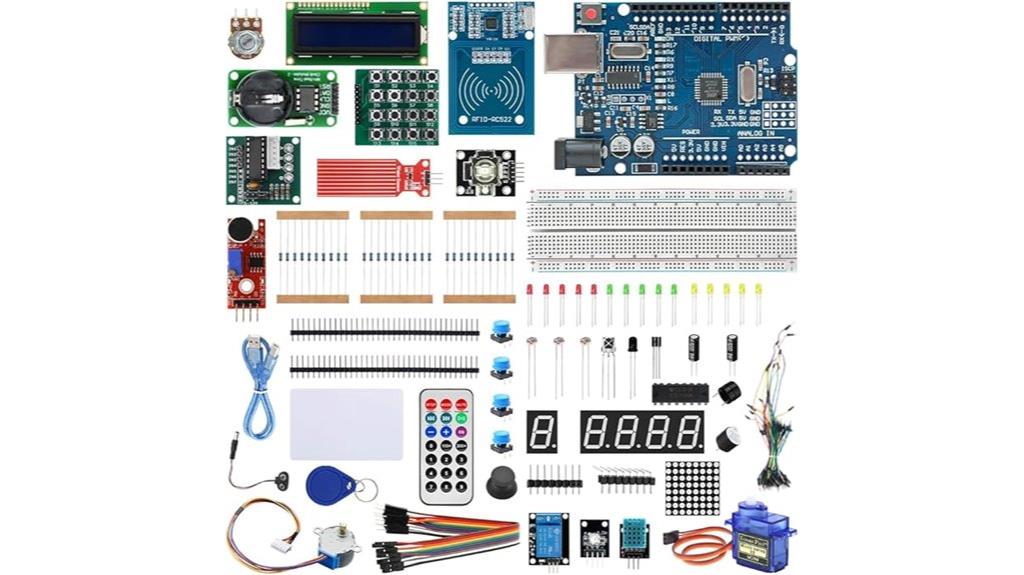
The Super Starter Kit with RFID Module and Microcontroller Board for Arduino is an excellent choice for beginners and hobbyists enthusiastic to plunge into robotics and electronics projects. It includes a high-quality microcontroller compatible with Arduino IDE, along with essential components like LEDs, buttons, and RFID modules, all organized in a convenient case. Designed for easy integration with Arduino UNO R3, it’s perfect for learning programming and building DIY projects. While not authentic Arduino, it offers a solid platform for experimentation. With positive reviews, this kit provides a fun, accessible way to develop technical skills and explore robotics, making it a valuable starter for any aspiring maker.
Best For: beginners and hobbyists looking to start exploring robotics, electronics, and Arduino programming with an easy-to-use, organized starter kit.
Pros:
- Compatible with Arduino IDE and UNO R3, ensuring straightforward integration and ease of use.
- Comes with a comprehensive selection of components, including RFID modules, LEDs, and buttons for versatile projects.
- Packaged in a compartmentalized case that keeps parts organized and accessible, ideal for learning and experimentation.
Cons:
- Not an authentic Arduino product, which may impact compatibility or authenticity perceptions.
- Some users report issues with Arduino Uno resets and RTC stability during use.
- Limited detailed instructions or tutorials included, requiring users to seek additional resources for complex projects.
Factors to Consider When Choosing Microcontroller Kits for Robotics
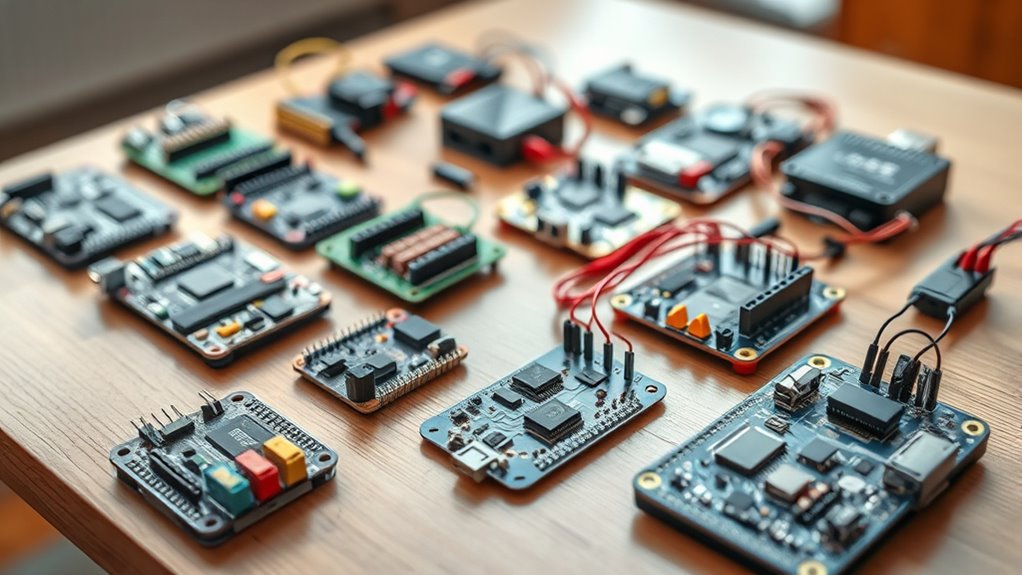
When selecting a microcontroller kit for robotics, I consider several key factors that can impact your project’s success. Things like compatibility with your chosen platform, the quality and amount of components included, and the availability of learning resources all matter. Additionally, ease of assembly and options for future expansion are important to guarantee your robot can grow with your skills.
Compatibility With Platforms
Making certain that your microcontroller kit is compatible with your chosen platform is crucial for smooth integration and successful project development. I always check if the kit supports platforms like Arduino, Raspberry Pi, or BeagleBone to avoid compatibility issues later. It’s necessary to verify that the kit supports the specific microcontroller models or development boards I plan to use. I also make sure that software libraries and development environments are available for my platform, which makes programming and troubleshooting much easier. Additionally, I examine the connectors, communication protocols, and expansion interfaces to ensure they match my platform’s standards. If the kit includes or supports adapters and shields designed for my platform, it adds versatility and scalability, making my robotics projects more efficient and adaptable.
Component Quality and Quantity
Choosing a microcontroller kit with the right components involves more than just compatibility; the quality and quantity of parts considerably impact your project’s success. High-quality components ensure durability, reliable performance, and accurate results, reducing the need for frequent replacements. The quantity of parts should match your project’s complexity, providing enough sensors, actuators, and modules for growth and experimentation. Poorly manufactured parts can cause connection issues, sensor malfunctions, or inconsistent behavior, hampering your learning and building experience. A thorough kit with a variety of components allows for diverse projects without immediate additional purchases. Additionally, well-organized, well-documented parts make assembly, troubleshooting, and understanding systems much easier, saving you time and frustration as you develop your robotics skills.
Learning Resources Availability
Have you checked if the microcontroller kit comes with extensive learning resources? I find that comprehensive tutorials, guides, and online materials are essential for smooth learning and troubleshooting. Make sure the kit offers step-by-step project instructions and example codes tailored to the included hardware—this simplifies the building process. It’s also helpful if the manufacturer provides supplementary educational content, like videos, PDFs, or community forums, for ongoing support. I prioritize kits with updated tutorials compatible with current software versions and programming environments, ensuring future-proof learning. Finally, I assess the quality and clarity of the documentation, as clear instructions make a big difference, especially for beginners. Good learning resources can turn a good kit into a truly effective tool for mastering robotics projects.
Ease of Assembly
When evaluating microcontroller kits for robotics, ease of assembly plays a key role in your overall experience. A well-designed kit should feature pre-wired components, color-coded cables, and step-by-step instructions that reduce confusion. For beginners, modular parts that snap or plug together eliminate the need for soldering and specialized tools, making setup quicker and more straightforward. Detailed tutorials, visual diagrams, and assembly videos can further simplify the process, especially for those with limited experience. Shorter assembly times and minimal complex connections indicate a user-friendly design, ideal for educational settings or hobbyist projects. Feedback from other users also helps determine if a kit is suitable for novices or better suited for those with more advanced skills, guiding your choice effectively.
Expandability Options
Expandability options are essential to contemplate because they determine how easily a microcontroller kit can grow with your project. I look for kits that support a variety of sensors, actuators, and modules like Wi-Fi, Bluetooth, or cameras, which expand functionality. The availability of expansion ports—GPIO, I2C, SPI, UART—is vital, as it defines what peripherals I can connect simultaneously. Modular design features, such as plug-and-play connectors and standardized interfaces, make adding components straightforward without extensive rewiring. I also consider support for software libraries and open-source environments, which simplify integrating new modules as my project evolves. Some kits offer expansion shields or daughterboards for specific functionalities like GPS or environmental sensors, making scaling projects more manageable and efficient.
Software and Coding Support
Choosing a microcontroller kit with strong software and coding support is essential because it directly impacts how easily I can develop, troubleshoot, and refine my robotics projects. I look for kits that include compatible IDEs, libraries, and example codes to streamline programming and problem-solving. Access to tutorials, documentation, and active community forums helps me learn faster and resolve issues quickly. Supporting multiple programming languages, like C++, Python, or visual block coding, lets me choose the best tool for my skill level and project complexity. I also verify that firmware updates and ongoing software support are available, ensuring compatibility with new features and hardware revisions. An easy-to-use environment for uploading, debugging, and modifying code is critical for iterative development and experimentation.
Frequently Asked Questions
Which Microcontroller Kit Offers the Best Compatibility With Various Sensors?
I find the Arduino Starter Kit offers the best compatibility with various sensors. Its widespread use means there’s plenty of documentation and community support, making it easier to connect and experiment with different sensors like ultrasonic, temperature, and motion sensors. The kit’s versatile I/O pins and open-source platform allow me to easily integrate new sensors and expand my robotics projects without hassle.
Are Beginner-Friendly Kits Suitable for Advanced Robotics Projects Later On?
Yes, beginner-friendly kits can be suitable for advanced robotics projects later on. I’ve found that many come with modular components and expandability options, allowing me to start simple and gradually add more complex features. These kits often include thorough tutorials, which help me build foundational skills. As I grow more confident, I can upgrade or customize my setup, making the shift to advanced projects smooth and manageable.
How Important Is the Availability of Tutorials and Community Support?
The availability of tutorials and community support is vital for me when choosing a microcontroller kit. It helps me troubleshoot issues quickly and learn new skills more effectively. I value active communities where I can ask questions, share ideas, and find inspiration. With strong support and resources, I feel confident experimenting and pushing my projects further, making these aspects essential for a successful robotics journey.
What Is the Typical Power Supply Requirement for These Kits?
Oh, the thrilling world of power supplies—because who doesn’t love a little voltage adventure? Most microcontroller kits run on 5V to 12V DC power, often via USB or wall adapters. Some kits even boast built-in rechargeable batteries, making them perfect for on-the-go robotics escapades. Just remember, a stable power source is the secret sauce to keeping your project alive and kicking—no one likes a sleepy robot!
Do These Kits Include Necessary Tools or Accessories for Assembly?
Most of these kits include essential tools and accessories needed for assembly, such as jumper wires, sensors, and sometimes a small screwdriver. However, I recommend checking each kit’s contents beforehand because some might require you to purchase additional items like batteries or specialized tools separately. I’ve found that having a basic toolkit at home really helps streamline the assembly process and boosts my project success.
Conclusion
Choosing the right microcontroller kit is like finding the perfect key to open your robotics potential. With so many options, you’re equipped to build anything from simple robots to complex projects. Just remember, the best kit is the one that sparks your curiosity and fuels your creativity. Embark on, experiment, and let your imagination be the guiding compass—your next great robotic adventure awaits just beyond the horizon.
